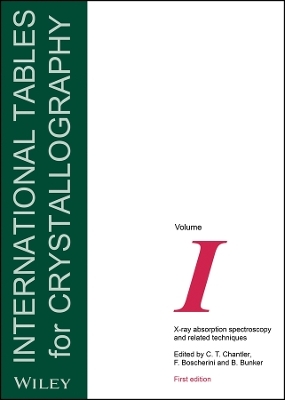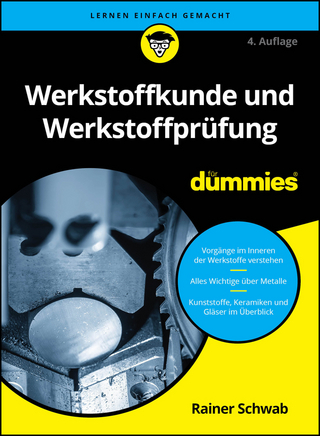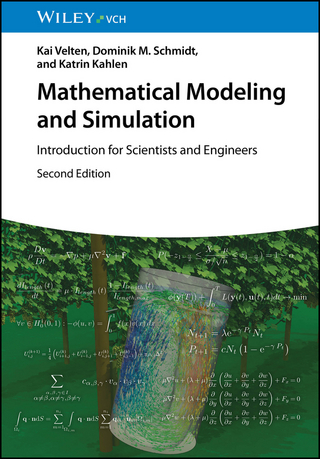
International Tables for Crystallography, Volume I
John Wiley & Sons Inc (Verlag)
978-1-119-43394-1 (ISBN)
This new volume of International Tables for Crystallography has nine parts and over 150 chapters contributed by a wide range of international experts.
Part 1 provides a brief overview and introduction to the background of X-ray absorption spectroscopy (XAS) and experimental facilities.
Part 2 discusses the quantum theory of XAS and related approaches.
Part 3 describes both standard and advanced experimental methods used in XAS, X-ray emission spectroscopy (XES) and related techniques.
Part 4 covers both standard and more advanced pre-processing of data.
Part 5 gives an extensive overview of the analysis of experimental data.
Part 6 provides details of the major software packages for data collection, reduction and analysis.
Part 7 outlines the importance in science, reporting and hypothesis testing of the exchange of input and processed output data, and data deposition. It also presents excerpts of tables of data and supplementary material for XAS, pre-edge studies, X-ray absorption near-edge spectroscopy (XANES) and X-ray absorption fine structure (XAFS) studies. These tables are also available in full as online supporting information.
Part 8 explores a wide range of applications of XAS in fields including materials science, physics, chemistry, biology, earth sciences, catalysis and cultural heritage.
Part 9 presents definitions of the terms and quantities used, as developed by the International Union of Crystallography's Commission on XAFS.
The volume has been written for the worldwide XAS community of thousands of practitioners, beamline scientists, experts and academics, and for the novice user who wishes to know what XAS and XES can do for them and how they may use these techniques for their particular purposes. The volume is therefore intended to be a self-contained, authoritative reference work that can also be used for training, learning or teaching, providing practical guidance for readers of all levels of experience.
More information on the volumes in the series International Tables for Crystallography can be found at https://it.iucr.org.
Part 1. Introduction
1.1. Overview of International Tables for Crystallography Volume I
1.2. Facilities
1.3. Deposition of XAFS data
1.4. Perspectives for the future for X-ray absorption spectroscopy and related techniques
Part 2. Theory
2.1. X-ray interactions with matter
2.2. Tensorial interactions of X-rays
2.3. Multiple-scattering theory of X-ray absorption spectroscopy as a structural tool
2.4. Multiplet approaches in X-ray absorption spectroscopy
2.5. XANES: theory and approaches
2.6. EXAFS: theory and approaches
2.7. Pre-edge structure, selection rules and quadrupole contributions
2.8. XAFS with secondary process modalities and introduction to fluorescence and nonradiative processes
2.9. Inelastic scattering of electrons in solids
2.10. Green’s functions applied to the theory of spectroscopy
2.11. Finite-difference method for the calculation of X-ray spectroscopies
2.12. Density-functional theory approaches to XAS in solids
2.13. Core-hole potentials and related effects
2.14. Thermal effects on EXAFS
2.15. Relativistic effects on energies, transitions and basis states
2.16. X-ray linear dichroism: dependence of XAFS on the orientation of the sample with respect to the incoming radiation
2.17. Magnetic ordering and its influence on X-ray spectroscopies
2.18. Magnetic X-ray techniques
2.19. Inelastic X-ray scattering
2.20. X-ray excited optical luminescence
2.21. Diffraction anomalous fine structure: basic formalism
2.22. Combined approaches and challenges: XAS and UV–visible and vibrational spectroscopy
2.23. Combined approaches and challenges: XAS and X-ray diffraction
2.24. Sum rules for the analysis of nuclear resonant absorption spectra
2.25. Significance and tables of key physico-chemical parameters
Part 3. Experimental methods
3.1. X-ray sources
3.2. Synchrotron sources
3.3. Beamlines
3.4. Bragg crystal monochromators
3.5. Grating-based monochromators
3.6. Energy-scanning and energy-dispersive spectrometers for XAFS
3.7. Beam drift, control and polarization
3.8. Micro- and nano-XAFS: spatially resolved XAFS
3.9. X-ray focusing methods for X-ray absorption spectroscopy
3.10. Control of X-ray polarization
3.11. Mechanical stability of fast hard X-ray spectroscopy beamlines
3.12. Sample preparation
3.13. Sample-thickness effects
3.14. Accurate data: mapping sample absorption and thickness effects
3.15. Liquids and gels
3.16. Solutions
3.17. Gases
3.18. Thin and ultrathin films and multilayers
3.19. Ultradilute systems
3.20. Mixed-phase heterogeneity in solutions
3.21. Biological samples
3.22. Surfaces
3.23. Radioactive samples
3.24. XAS cryostats and cryogenic studies
3.25. Cells for spectroscopy of fluids at elevated pressure and temperature
3.26. In situ and operando catalysis: instrumentation and experimental setups
3.27. Electrochemical cells for in situ XAS studies
3.28. Soft X-ray absorption spectra
3.29. XAFS and thermodynamic variables to investigate matter
3.30. Extreme conditions: high pressure/high temperature
3.31. Electron yield: total, Auger and photoemission
3.32. Experimental apparatuses for ReflEXAFS studies
3.33. X-ray magnetic circular dichroism
3.34. Diffraction anomalous fine structure: experiment and data analysis
3.35. X-ray fluorescence detection for EXAFS
3.36. Ion-chamber detectors
3.37. Nonlinearities in solid-state fluorescence detectors
3.38. Harmonic contamination and its effects on measurements
3.39. Daisy wheels and the monitoring, measurement and correction of harmonic contamination and fluorescence background
3.40. Special considerations for insertion-device beamlines
3.41. Geometry for data collection
3.42. Energy calibration for X-ray spectroscopy using powder and single-crystal standards
3.43. The X-ray extended-range technique for higher accuracy measurements and higher significance of X-ray absorption spectroscopy results
3.44. Self-absorption corrections
3.45. Bandwidth and divergence
3.46. Multiple-sample approaches: standard downstream reference-sample calibration
and multiple active samples
3.47. Projected roughness in X-ray absorption spectroscopy
3.48. Other calibration and diagnostic tools
3.49. Experimental arrangements for inelastic X-ray scattering spectroscopy
Part 4. Spectral distortions and data pre-processing
4.1. Spectral distortions and pre-processing of experimental data
4.2. XAFS spectral distortions related to optics issues
4.3. Sample-related issues
4.4. Detector-related issues
4.5. ReflXAFS data analysis
4.6. Data acquisition and determination of precision and uncertainty
4.7. Absolute measurement of X-ray absorption spectroscopy
Part 5. Analysis of experimental data
5.1. Background removal
5.2. Oversampling and conversion to k-space
5.3. Fourier transforms in EXAFS
5.4. Multiple-scattering EXAFS analysis
5.5. Shake-up and shake-off processes
5.6. Extraction of v: calibrations and limitations
5.7. Goodness-of-fit measures in XAS, v2 calibrations and limitations, and hypothesis testing
5.8. Statistical measures of confidence
5.9. Unknown systematic errors and their impact on the information content of the data
5.10. Importance of theoretical calculations for phase shifts and amplitudes
5.11. The cumulant approach and the ratio method
5.12. Use of reference standards
5.13. Nonlinear least-squares fitting
5.14. Reverse Monte Carlo and molecular-dynamics approaches to EXAFS analysis
5.15. Bayesian techniques: an overview
5.16. Normalization of XANES spectra
5.17. Fingerprinting: principal component analysis and linear combination fitting
5.18. Statistical analysis in XANES spectroscopy
5.19. Comparing XANES calculations with experiment
Part 6. Packages and approaches for data collection and data reduction
6.1. ATHENA and ARTEMIS
6.2. EDA: EXAFS data-analysis software package
6.3. ESTRA and FitEXA
6.4. Exciting core-level spectroscopy
6.5. EXCURVE
6.6. The FDMNES code
6.7. The FDMX code
6.8. The FEFF code
6.9. FitIt
6.10. FPMS: full potential multiple scattering
6.11. GNXAS. I. Phase shifts and signal calculations
6.12. GNXAS. II. Structural refinement of experimental data
6.13. IFEFFIT and LARCH
6.14. LASE: Logiciel d’Analyse des Spectres Expe´rimentaux
6.15. Multiplatform Applications for XAFS
6.16. MXAN: a method for the quantitative structural analysis of the XANES energy region
6.17. The OCEAN suite: core excitations
6.18. PrestoPronto: a software package for large EXAFS data sets
6.19. Real-Space X-ray Absorption Package
6.20. SIXPACK: a graphical user interface for XAS analysis
6.21. VIPER and XANES Dactyloscope
6.22. WIEN2k: an augmented plane wave plus local orbital package for the electronic structure of solids
6.23. xafsX: a program to process, analyse and reduce X-ray absorption fine-structure spectra
6.24. XFIT
6.25. XSpectra: a density-functional-theory-based plane-wave pseudopotential code for XANES calculation
Part 7. Exchange of data and deposition
7.1. Developing specifications for XAFS information interchange
7.2. Validation procedures for XAFS
7.3. The Open Source Database of the Japanese XAFS Society
7.4. Tables and supplementary material for X-ray absorption spectroscopy, pre-edge, XANES and XAFS
Part 8. Applications
8.1. Photoexcitation processes in atoms
8.2. Semiconductors
8.3. Many-body quantum physics in XANES of highly correlated materials, mixed-valence oxides and high-temperature superconductors
8.4. Magnetism and magnetic materials
8.5. Liquids, glasses and amorphous solids
8.6. X-ray absorption spectroscopy under extreme conditions of pressure
8.7. Nuclear materials
8.8. Surfaces and interfaces
8.9. Nanoclusters
8.10. Selected case studies in heterogeneous catalysis
8.11. EXAFS applications in coordination chemistry
8.12. Time-resolved optical pump/X-ray absorption spectroscopy probe
8.13. Metalloproteins and systems of biological relevance
8.14. Applications of XAS in earth sciences
8.15. Environmental applications of X-ray spectroscopy
8.16. The use of XAS and related methods in cultural heritage investigations
8.17. Studies of fundamental photoexcitation and photoelectron-scattering processes
8.18. Quick EXAFS studies in catalysis
Part 9. Definitions
9.1. X-ray absorption spectroscopy definitions
| Erscheinungsdatum | 22.08.2024 |
|---|---|
| Reihe/Serie | IUCr Series. International Tables for Crystallography |
| Verlagsort | New York |
| Sprache | englisch |
| Maße | 224 x 277 mm |
| Gewicht | 3289 g |
| Themenwelt | Naturwissenschaften ► Chemie |
| Technik ► Maschinenbau | |
| ISBN-10 | 1-119-43394-0 / 1119433940 |
| ISBN-13 | 978-1-119-43394-1 / 9781119433941 |
| Zustand | Neuware |
| Informationen gemäß Produktsicherheitsverordnung (GPSR) | |
| Haben Sie eine Frage zum Produkt? |
aus dem Bereich


